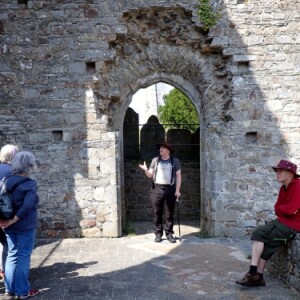Wall have ears
Several pairs were glued to the words of local historian Glen Johnson as he took us on a tour around the ancient ruined abbey of St Dogmaels, that has for centuries stood above the river Teifi across from the town of Cardigan/Aberteifi.
Glen has spent thirty years as an independent historian, researching, photographing and publishing material on the area and has been instrumental in the restoration of Cardigan Castle following its purchase by the town from its private owner.
Forbidding us to step "through" the razed walls, Glen (extra) took us around the ground plan of the priory explaining the purpose of each room and how the community functioned, how the monks would have spent their days (and nights) and how they would have ended them - in the infirmary benefitting from the sort of end-of-life care that would not have been available to anyone in the middle ages.
Everyone asks: what was the purpose of the square holes that dot the ruined walls in a regular pattern? Glen kept us waiting to explain: they are putlog* holes created by a form of scaffolding that involves fixing beams through the walls as they are being built. On completion the beams were removed leaving behind square holes which were closed up with wooden inserts. When painted over (all the walls would have been lime washed inside and out) the gaps would be invisible but over the course of time the wooden blocks rotted away and fell out.
If you're ever in St Dogmael's [and I know one blipper who will be] do try and catch Glen's profoundly knowledgeable and entertaining take on the past. The local history group meets in The White Hart on Thursdays. evenings.
Modern putlog scaffolding explained.
*Nothing to do with ears and other sorts of lugs which stick out rather than go in.


Comments
Sign in or get an account to comment.


